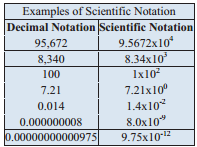5.2: Scientific Notation
- Page ID
- 50296
Skills to Develop
- Identify when scientific notation is useful to record measurements.
- Convert measurements to scientific notation.
- Convert quantities from scientific notation to their standard numerical form.
Work in science frequently involves very large and very small numbers. The speed of light, for example, is 300,000,000 meters/second; the mass of the earth is 6,000,000,000,000,000,000,000,000 \(\text{kg}\); and the mass of an electron is 0.0000000000000000000000000000009 \(\text{kg}\). It is very inconvenient to write such numbers and even more inconvenient to attempt to carry out mathematical operations with them.
What is Scientific Notation?
Scientists and mathematicians have designed an easier method for dealing with such numbers. This more convenient system is called exponential notation by mathematicians and scientific notations by scientists.
In scientific notation, very large and very small numbers are expressed as the product of a number between 1 and 10 multiplied by some power of 10. The number 9,000,000 for example, can be written as the product of 9 times 1,000,000 and 1,000,000 can be written as \(10^{6}\). Therefore, 9,000,000 can be written as \(9 \times 10^6\). In a similar manner, 0.00000004 can be written as \(4 \times \frac{1}{10^8}\) or \(4 \times 10^{-8}\).


As you can see from the examples above, to convert a number from decimal form to scientific notation, you count the spaces that you need to move the decimal and that number becomes the exponent of 10. If you are moving the decimal to the left, the exponent is positive and if you are moving the decimal to the right, the exponent is negative.
Calculators and Scientific Notation
Because you will be performing calculations using scientific notation, it is important that you understand how your calculator uses scientific notation. For this course, you will need a scientific or graphing calculator. These calculators have an "exponential" button. It is typically labeled "EXP" or "EE" and can be read "times ten to the . . ." Consider the following number: \(6.02 \times 10^{23}\). If you were to read this out loud, you would say "6.02 times ten tor the 23\(^\text{rd}\)." To type this in your calculator, you would put "6.02EE23" or "6.02EXP23". Most calculators would print 6.02E23. By properly using the exponential button, you will avoid common mistakes made by students when multiplying or dividing these numbers.
Example
Perform the following calculation correctly using the exponential button.
\[\frac{1.20 \times 10^{24}}{6.02 \times 10^{23}}\]
Solution
To type this in my calculator, I would type:
\(1.20EE24 \div 6.03EE23\) OR \(1.20EXP24 \div 6.02EXP23\)
The answer is 2.0. *Be careful to look on the far right of your calculator screen. If you see E47 or a 47 typed offset, you typed it in wrong. Try again.
Summary
-
Very large and very small numbers in science are expressed in scientific notation.
Vocabulary
- Scientific notation: A shorthand method of writing very large and very small numbers in terms of a decimal number between 1 and 10 multiplied by 10 to a power.

